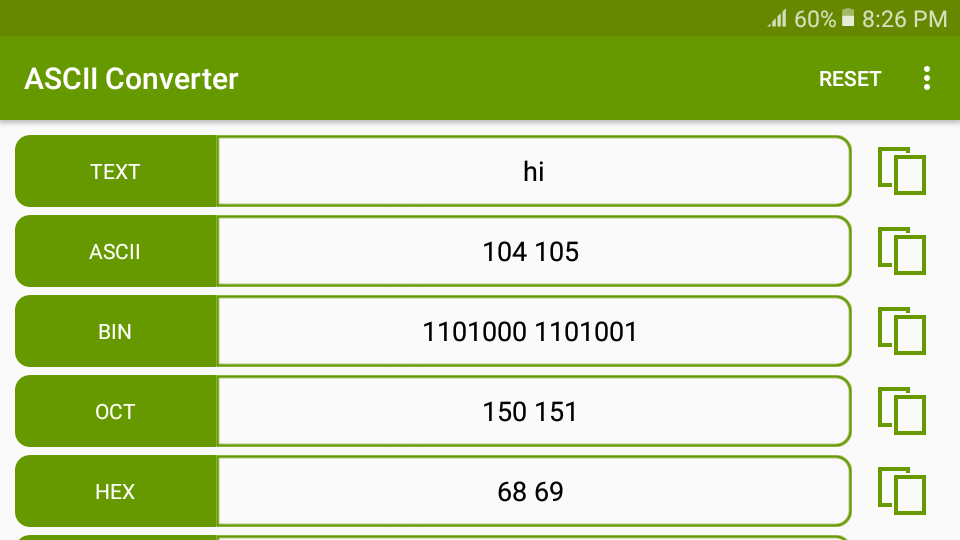
Ascii converter
Created on 7 October, 2024 • Converter Tools • 117 views • 3 minutes read
ASCII Converter: A Comprehensive Guide
An ASCII converter is a useful tool for transforming text, numbers, or symbols into their respective ASCII (American Standard Code for Information Interchange) values. ASCII is a character encoding standard that assigns unique numeric values to letters, digits, and other characters, enabling easy communication between computers. In this guide, we'll explore what an ASCII converter is, how it works, and its practical uses.
Understanding ASCII Converters and Their Importance
ASCII is widely used in computing systems, programming, and data processing. Knowing how to convert text to ASCII values can be essential for developers, data scientists, and anyone working with system-level text manipulation. ASCII converters simplify this process by automatically converting text into its ASCII format.
What is an ASCII Converter?
An ASCII converter is a tool that converts readable text into its corresponding ASCII code and vice versa. ASCII assigns a specific number to each character (for example, "A" is 65, "a" is 97, and "0" is 48). ASCII converters are used to convert characters like letters, digits, and punctuation marks into their ASCII values, making it easier to encode and decode information.
How Does ASCII Work?
ASCII is based on a 7-bit binary code that represents text. Each character is assigned a unique number between 0 and 127, with additional extended ASCII codes up to 255. This enables computers to interpret and process text in a standardized way, making the conversion process between text and binary or numeric formats seamless.
Benefits of Using an ASCII Converter
ASCII converters offer several practical benefits in various fields, from software development to cryptography. Here are a few key advantages of using an ASCII converter:
1. Simplifies Text Encoding
One of the primary uses of an ASCII converter is to encode text in a way that machines can understand. For example, in low-level programming, ASCII values are often needed to perform certain operations, and converters simplify the process of obtaining those values.
2. Assists in Data Processing
Data processing systems often require ASCII codes for storing and transmitting information. ASCII converters help in formatting text into numeric data that can be easily processed by machines.
3. Useful in Programming
Many programming languages use ASCII codes when manipulating strings or creating encryption algorithms. ASCII converters can quickly convert characters into their ASCII equivalents, saving time and reducing errors in coding.
4. Encoding and Decoding Binary Data
ASCII converters are frequently used in encoding binary data into readable text for transmission purposes. This ensures that data is transferred safely and accurately between systems.
How to Use an ASCII Converter
Using an ASCII converter is typically straightforward. Here’s a step-by-step guide on how to convert text into ASCII and vice versa.
Step 1: Enter Your Text
Input the text or characters that you want to convert into an ASCII converter tool. You can usually input anything from letters to punctuation marks.
Step 2: Convert to ASCII Code
Once the text is entered, the ASCII converter will instantly provide the corresponding ASCII code for each character. For example, typing "Hello" will output the following ASCII codes: 72 101 108 108 111.
Step 3: Convert ASCII to Text
Many ASCII converters also allow you to reverse the process by converting numeric ASCII codes back into text. Input the ASCII values, and the converter will display the corresponding text.
Applications of ASCII Converters
ASCII converters are used in a variety of fields where precise character encoding is necessary. Here are some common applications:
1. Web Development
In web development, ASCII codes are sometimes used in HTML or CSS to represent characters that might otherwise cause display issues in browsers.
2. Cryptography
ASCII values are often involved in encryption and decryption algorithms, making ASCII converters useful tools in cryptography for encoding and decoding secret messages.
3. Network Communications
During data transmission, especially over the internet, converting text into ASCII codes ensures that the message is transmitted correctly and efficiently between different systems.
4. File Encoding
ASCII converters help developers encode files, such as text documents, in ASCII format for proper storage and retrieval across different systems.
Popular ASCII Converter Tools
There are numerous online ASCII converter tools available that make it easy to convert text to ASCII and vice versa. Here are some popular options:
1. RapidTables ASCII Converter
RapidTables offers an easy-to-use ASCII converter tool that allows you to input text and instantly see the ASCII code results. It also supports reverse conversion from ASCII to text.
2. ConvertBinary.com
ConvertBinary.com provides an efficient tool for converting both text to ASCII and ASCII to text, with a simple and user-friendly interface.
3. ASCIIConverter.net
This converter specializes in allowing users to convert both single characters and entire strings into ASCII format, making it a versatile option for various tasks.
Conclusion: Why You Should Use an ASCII Converter
An ASCII converter is an invaluable tool for developers, data analysts, and tech enthusiasts. It simplifies the process of encoding text into machine-readable formats and plays an essential role in programming, cryptography, and data transmission.
Popular posts
-
Ascii converterConverter Tools • 116 views
-
Hex converterConverter Tools • 106 views
-
Binary converterConverter Tools • 95 views
-
Case converterText Tools • 92 views
-
DNS LookupChecker Tools • 91 views